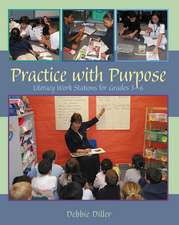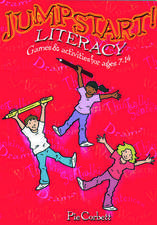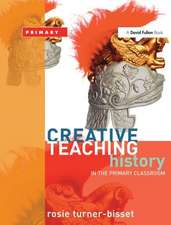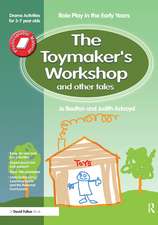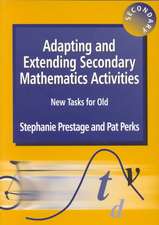Abraham Lincoln’s Cyphering Book and Ten other Extraordinary Cyphering Books
Autor Nerida F. Ellerton, M.A. (Ken) Clementsen Limba Engleză Hardback – 11 apr 2014
One of the cyphering books examined in this book was prepared, over the period 1819–1826, by a young Abraham Lincoln, when he was attending small one-teacher schools in remote Spencer County, Indiana. Chapter 6 in this book provides the first detailed analysis of young Abraham’s cyphering book—which is easily the oldest surviving Lincoln manuscript. Another cyphering book, this one prepared by William Beattie in 1835, could have been prepared as a special gift for the King of England. The analyses make clear the extent of the control which the cyphering tradition had over school mathematics in North America and Great Britain between 1630 and 1840.
In their final chapter Ellerton and Clements identify six lessons from their research into the cyphering tradition which relate to present-day circumstances surrounding school mathematics. These lessons are concerned with sharp differences between intended, implemented and attained curricula, the remarkable value that many students placed upon their cyphering books, the ethnomathematical circumstances which surrounded the preparations of the extraordinary cyphering books, and qualitative differences betweenBritish and North American school mathematics.
| Toate formatele și edițiile | Preț | Express |
|---|---|---|
| Paperback (1) | 811.52 lei 38-44 zile | |
| Springer International Publishing – 3 sep 2016 | 811.52 lei 38-44 zile | |
| Hardback (1) | 842.80 lei 38-44 zile | |
| Springer International Publishing – 11 apr 2014 | 842.80 lei 38-44 zile |
Preț: 842.80 lei
Preț vechi: 1108.96 lei
-24% Nou
Puncte Express: 1264
Preț estimativ în valută:
161.32€ • 175.29$ • 135.60£
161.32€ • 175.29$ • 135.60£
Carte tipărită la comandă
Livrare economică 16-22 aprilie
Preluare comenzi: 021 569.72.76
Specificații
ISBN-13: 9783319025018
ISBN-10: 3319025015
Pagini: 367
Ilustrații: XVIII, 367 p. 152 illus., 122 illus. in color.
Dimensiuni: 210 x 279 x 22 mm
Greutate: 1.41 kg
Ediția:2014
Editura: Springer International Publishing
Colecția Springer
Locul publicării:Cham, Switzerland
ISBN-10: 3319025015
Pagini: 367
Ilustrații: XVIII, 367 p. 152 illus., 122 illus. in color.
Dimensiuni: 210 x 279 x 22 mm
Greutate: 1.41 kg
Ediția:2014
Editura: Springer International Publishing
Colecția Springer
Locul publicării:Cham, Switzerland
Public țintă
ResearchCuprins
1.Cyphering Books and the Cyphering Tradition in North America and Great Britain, 1630–18.- 2.Primitive Beginnings, Circa 1667.- 3.“Thomas Prust His Booke Amen 1702”.- 4.Daughters of the Revolution: Martha and Elisabeth Ryan’s Cyphering Book, Circa 1780.- 5.With a Tinge of Green: Mary Watkins, 1820.- 6.He would be Good: Abraham Lincoln’s Early Mathematics, 1819–1826 (This chapter was authored by Nerida Ellerton, Valeria Aguirre Holguin, and M. A. (Ken Clements).- 7.Sacrobosco’s Heritage: Thomas Dixson’s Cyphering Book, 1630–1632.- 8.Writing as if Arithmeticke: George Bickham’s Cyphering Book, Circa 1740.- 9.Bound for Botany Bay? Circa 1791.- 10.From the Royal Mathematical School: Charles Page, 1825.- 11.Fit for a King? William Beattie, Circa 1810 and 1835–1836.- 12.Lessons from Extraordinary Cyphering Books.- References.- Index.
Textul de pe ultima copertă
This well-illustrated book provides strong qualitative and comparative support for the main arguments developed by Nerida Ellerton and Ken Clements in their groundbreaking Rewriting this History of School Mathematics in North America 1607–1861: The Central Role of Cyphering Books. Eleven extraordinary handwritten school mathematics manuscripts are carefully analyzed—six were prepared entirely in Great Britain, four entirely in North America, and one partly in Great Britain and partly in North America. The earliest of the 11 cyphering books was prepared around 1630, and the latest in 1835. Seven of the manuscripts were arithmetic cyphering books; three were navigation cyphering books, and one was a mensuration/surveying manuscript.
One of the cyphering books examined in this book was prepared, over the period 1819–1826, by a young Abraham Lincoln, when he was attending small one-teacher schools in remote Spencer County, Indiana. Chapter 6 in this book provides the first detailed analysis of young Abraham’s cyphering book—which is easily the oldest surviving Lincoln manuscript. Another cyphering book, this one prepared by William Beattie in 1835, could have been prepared as a special gift for the King of England. The analyses make clear the extent of the control which the cyphering tradition had over school mathematics in North America and Great Britain between 1630 and 1840.
In their final chapter Ellerton and Clements identify six lessons from their research into the cyphering tradition which relate to present-day circumstances surrounding school mathematics. These lessons are concerned with sharp differences between intended, implemented and attained curricula, the remarkable value that many students placed upon their cyphering books, the ethnomathematical circumstances which surrounded the preparations of the extraordinary cyphering books, and qualitative differences between British and North Americanschool mathematics.
One of the cyphering books examined in this book was prepared, over the period 1819–1826, by a young Abraham Lincoln, when he was attending small one-teacher schools in remote Spencer County, Indiana. Chapter 6 in this book provides the first detailed analysis of young Abraham’s cyphering book—which is easily the oldest surviving Lincoln manuscript. Another cyphering book, this one prepared by William Beattie in 1835, could have been prepared as a special gift for the King of England. The analyses make clear the extent of the control which the cyphering tradition had over school mathematics in North America and Great Britain between 1630 and 1840.
In their final chapter Ellerton and Clements identify six lessons from their research into the cyphering tradition which relate to present-day circumstances surrounding school mathematics. These lessons are concerned with sharp differences between intended, implemented and attained curricula, the remarkable value that many students placed upon their cyphering books, the ethnomathematical circumstances which surrounded the preparations of the extraordinary cyphering books, and qualitative differences between British and North Americanschool mathematics.
Caracteristici
High quality illustrations combine with extensive interpretive text The discovery of a "missing" page from Abraham Lincoln's cyphering book is announced and detailed Entirely Unique Content---no book like this has ever been published Includes supplementary material: sn.pub/extras








